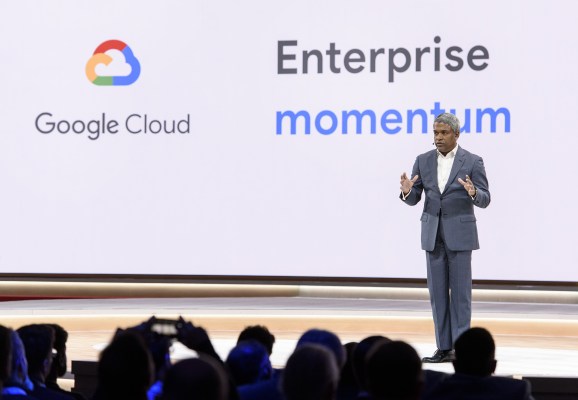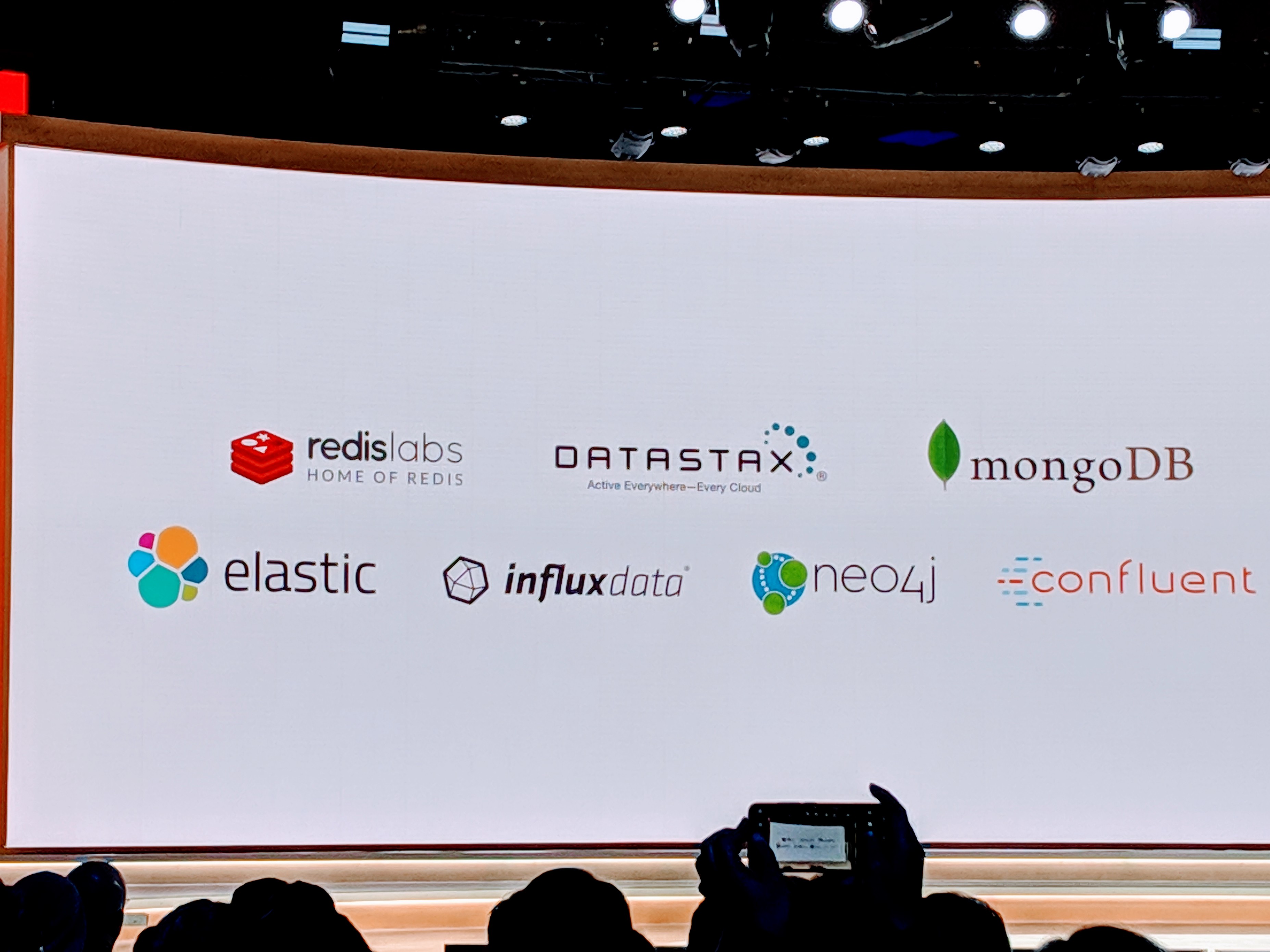“Yes.”
That was Google Cloud CEO Thomas Kurian’s simple answer when I asked if he thought he’d achieved what he set out to do in his first year.
A year ago, he took the helm of Google’s cloud operations — which includes G Suite — and set about giving the organization a sharpened focus by expanding on a strategy his predecessor Diane Greene first set during her tenure.
It’s no secret that Kurian, with his background at Oracle, immediately put the entire Google Cloud operation on a course to focus on enterprise customers, with an emphasis on a number of key verticals.
So it’s no surprise, then, that the first highlight Kurian cited is that Google Cloud expanded its feature lineup with important capabilities that were previously missing. “When we look at what we’ve done this last year, first is maturing our products,” he said. “We’ve opened up many markets for our products because we’ve matured the core capabilities in the product. We’ve added things like compliance requirements. We’ve added support for many enterprise things like SAP and VMware and Oracle and a number of enterprise solutions.” Thanks to this, he stressed, analyst firms like Gartner and Forrester now rank Google Cloud “neck-and-neck with the other two players that everybody compares us to.”
If Google Cloud’s previous record made anything clear, though, it’s that technical know-how and great features aren’t enough. One of the first actions Kurian took was to expand the company’s sales team to resemble an organization that looked a bit more like that of a traditional enterprise company. “We were able to specialize our sales teams by industry — added talent into the sales organization and scaled up the sales force very, very significantly — and I think you’re starting to see those results. Not only did we increase the number of people, but our productivity improved as well as the sales organization, so all of that was good.”
He also cited Google’s partner business as a reason for its overall growth. Partner influence revenue increased by about 200% in 2019, and its partners brought in 13 times more new customers in 2019 when compared to the previous year.
Integration partners like Accenture, Deloitte and Atos are also now bringing in significant business. The reason for that, Kurian believes, is that Google made it clear that it doesn’t want to be a services company. “We’re being a products and solutions company and we want the partners to deliver the services. So that makes it very clear to them that we want to partner with them,” he said.
But it’s not all enterprise sales. Kurian noted that Google Cloud also saw a major increase in interest in the platform from the developer community, citing the fact that Google Cloud Certified Architect is now one of the highest-paid jobs in IT. “That’s reflective of the demand for our capabilities,” he said.
And Kurian was also very excited about Google’s partnership with a number of open-source companies, like Elastic, Redis, Confluent and MongoDB, a move that many in the industry saw as a rebuke of AWS’s tactics of turning open-source code from these companies into its own revenue-generating cloud services.
“They have invested many years in building great products and creating a developer ecosystem,” Kurian said. “Google wanted to support them in their mission to provide these developers a platform to deploy their solutions on. So we did a partnership with them and it’s gone really, really well and there’s a lot of interest from the developer community because of what we did.”
Indeed, Kurian said partners and the overall ecosystem are the most important aspects of what will allow Google Cloud to succeed in the long term.
“Long-term, a platform that wins is differentiated not by just a solution that the cloud provider builds, but by the ecosystem of partners around it. If you look at mobile operating systems, if you look at any one of these domains — it is largely driven by not just the company’s offerings, but by the ecosystem. And so we’ve always been clear that we need to provide a platform that’s open and to attract partners to the platform, because they complement us in a number of ways and they broaden the set of solutions a customer can consume on our platform.”
With all of this, Kurian says Google Cloud’s conversations with customers have also changed dramatically, using the company’s recent travel industry deals with Sabre and Lufthansa as examples. Sabre, he said, needed not just a dependable infrastructure platform but also enterprise support — which may explain why Google Cloud introduced enhanced enterprise support offerings right around the time it announced those deals. “It’s because of all of that, that they were able to feel comfortable that the innovations that Google brings in its understanding of travel, coupled with the rock-solid support, and all of that that they will get.”
He also noted that Lufthansa is using Google’s AI tools to improve scheduling operations, among other things. But the company’s decision to move to Google Cloud was driven by a business decision and was a project that was driven by a business executive, he stressed. And that’s something the company is seeing more of now. It’s not just selling to IT, but to individual business units that have specific infrastructure needs.
Today’s Google Cloud, Kurian argues, doesn’t just have all of the basic features and support options in place that enterprises need, but it has also created a sales organization that can work with these companies and sign complex deals. “There’s a lot of basic things now that we’re very competitive on, but can you sign a very complex contract with us? Yes, you can. It used to [take] a lot longer before. Today you can,” he said. “Can you get the same level of support from Google as you could from another cloud provider or any enterprise software company? You absolutely can. Do we have salespeople who are just as capable in understanding complex organizations with very complex needs today as any other company? Absolutely.”
Kurian also stressed that Google Cloud is now working more with units across Alphabet to sell to companies like Activision Blizzard, which signed a deal that included a number of Alphabet services, not just with Google Cloud but also with YouTube and Android. Between that and the fact that Google is building a lot of industry-specific solutions, Kurian said the organization is on the right path.
He added that these industry-specific solutions — and, more broadly, Google Cloud’s overall focus on a number of verticals — is paying off.
“One, it’s brought focus to our product organization on what products we build,” he said. “Second, it has helped organize our sales organization. So for instance, if you’re a bank and you have a salesperson, our salesperson is someone who understands banking. So when we explain the value proposition or identify projects and programs, it helps us answer questions in the right way. […] The third is, it has also helped us define which partners we need to work with.”
As for products, Anthos was probably the most significant addition to Google Cloud’s infrastructure portfolio. Anthos, which got its start before Kurian became CEO, allows for easier hybrid and multi-cloud operations that let enterprises manage legacy and new applications across clouds and on-premises data centers. Anthos, he says, is a major differentiator for Google Cloud.
But Google also made a number of significant acquisitions, including Looker (though that deal hadn’t yet closed when I talked to Kurian) and Elastifile. “We’ve acquired things that complement our products,” he explained. “So if you look at Elastifile, it provides an elastic file system very complementary to our storage offering. When we brought Chronicle into Google Cloud from another part of Alphabet, it was to strengthen our security portfolio. If you look at Looker, it really complements our analytics foundation BigQuery and provides a visualization layer on top of BigQuery. So every time we think about it, we’re always looking for complementary offerings that strengthen our core segments and our core product offerings.”
Shortly after our conversation, Google Cloud went through a small reorg that reportedly eliminated about 50 positions. Given Kurian’s focus on specific verticals, that move didn’t really surprise me (and these kinds of reorgs are very much par for the game at any large organization). Indeed, I would be surprised if we didn’t see more of this in the coming year as Kurian continues to sharpen Google Cloud’s overall focus.
Given the company’s recent earnings report, that focus is clearly paying off, after all.


